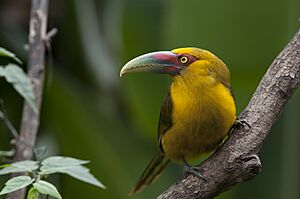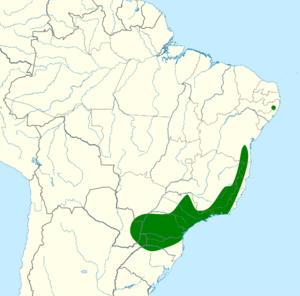Saffron toucanet facts for kids
Quick facts for kids Saffron toucanet |
|
|---|---|
 |
|
| Conservation status | |
| Scientific classification | |
 |
|
| Synonyms | |
|
The saffron toucanet (Pteroglossus bailloni) is a colorful bird that lives in the Atlantic Forest in South America. You can find it in parts of Argentina, Brazil, and Paraguay. It's known for its bright saffron yellow color, which is quite unique among toucans! This bird is part of the toucan family.
Contents
About the Saffron Toucanet's Name
The saffron toucanet's scientific name, Pteroglossus bailloni, honors a person named Louis Antoine François Baillon. People have called this bird by a few different names over time, like Baillon's toucan, banana toucan, and yellow toucanet. Scientists have studied its DNA and other features to figure out its correct place in the bird family tree. They found it belongs in the group of toucans called Pteroglossus.
What Does the Saffron Toucanet Look Like?
This toucan is about 35 to 40 centimeters (14 to 16 inches) long, which is roughly the length of a school ruler. It has a fairly long tail. As its name suggests, it's mostly a bright saffron yellow color. This is very unusual for a toucan!
Its back and tail are a darker, olive-green color. It has red patches around its eyes and at the base of its bill. The bill itself is greenish-horn colored. Its eyes are a pale yellowish color.
Male and Female Differences
Male and female saffron toucanets look a little different. This is called being dimorphic.
- Adult males have a golden head and chest. Their wings, shoulder feathers, and back are olive green, and their rump (the area above the tail) is red. Their bill is medium-sized and has green, grey-blue, and yellowish-grey colors.
- Adult females look similar to males but have more olive and less gold color on their bodies. They also have a shorter bill.
- Young toucanets are mostly olive and grey. They have brown eyes and a bill that looks a bit blotchy.
Where Saffron Toucanets Live
The saffron toucanet lives in the Atlantic Forest, a special type of forest in South America. Scientists believe this toucan group separated from other toucans about 3 million years ago. The saffron toucanet is separated from its closest relatives by a large area of dry grassland called the Brazilian savanna. It's thought that these toucanets stayed in the Atlantic Forest because they couldn't adapt to live in the savanna.
Forest Homes and Fragmentation
Saffron toucanets need forests to survive. They are considered "endemic" to the Atlantic Forest, meaning they are native only to this area. Studies show that these birds are very sensitive to forest fragmentation. This happens when large forests are broken up into smaller, separate pieces, often by human activities like building or farming.
When forests are fragmented, it's harder for toucanets to move around and find food or new mates. If their local forest patch disappears, they might not have other nearby populations to join. This makes them more vulnerable to disappearing from an area.
How Saffron Toucanets Behave and Live
Saffron toucanets are known as "frugivores," which means they mainly eat fruit. They have a large mouth opening, which helps them eat big fruits. Because they can carry larger seeds to new places, they are very important for spreading the seeds of certain plants. This helps new plants grow in different areas of the forest.
Scientists have found that species like the saffron toucanet, which play a big role in connecting different parts of the forest ecosystem, are sometimes at a higher risk of extinction. If these important connections are lost, it can harm many other plants and animals in the forest.
Reproduction and Nests
Saffron toucanets start building nests around October, with most active nests seen in November. They make their nests inside holes in trees. These holes are usually between 20 and 68 centimeters deep, with an entrance hole about 4 to 7.4 centimeters wide. The nests are typically high up in trees, from 7 to 24 meters off the ground.
Because they are not very large birds, they don't need huge holes for their nests. This means they don't have to compete as much with other animals for good nesting spots. They prefer to nest in living trees like the Garapa (Apuleia leiocarpa) and Aspidosperma australe. They usually don't reuse the same tree holes for their nests each year.
During courtship, the male toucanet will sing and feed the female. They also groom each other's feathers. The female lays two or three eggs. Both parents take turns sitting on the eggs for about 16 days until they hatch.
Food and Eating Habits
The main part of the saffron toucanet's diet is fruit, especially figs and palm fruits. However, they have also been seen eating young birds. In one observation, a saffron toucanet quickly entered a red-rumped cacique nest, swallowed the young birds inside, and flew away in less than 30 seconds! Their smaller size might help them perch on nests and get in and out quickly. Another time, one was seen trying to attack a White-spotted woodpecker nest, but it wasn't successful.
Status and Threats
The saffron toucanet is currently considered "Near Threatened" by conservation groups like BirdLife International. This means it could become endangered in the future if its situation doesn't improve.
Dangers to the Saffron Toucanet
The biggest dangers to the saffron toucanet are:
- Habitat loss: The destruction of their forest homes.
- Habitat degradation: When their forest homes become unhealthy or damaged.
- Hunting: People hunting them.
- Being captured: Being caught for the illegal pet trade.
They live in some protected areas, like Itatiaia National Park and Intervales State Park in Brazil, which helps keep them safe.
Health Concerns
Scientists have studied diseases that can affect saffron toucanets. One parasite, Chlamydophila psittaci, can be passed between birds and even to humans. While it doesn't always show clear symptoms in birds, it can still spread. Saffron toucanets have shown signs of fighting off this disease.
Another parasite, called microfilariae, was found in one saffron toucanet at a zoo. Birds in captivity are more likely to get diseases than wild birds, so zoos regularly check their health.
Human-Made Threats
Besides health issues, saffron toucanets face threats from people. They are popular in the illegal bird trade, and some are hunted. When forests are cut down into smaller pieces, these birds are more likely to disappear from those areas. Conservationists are working to protect large forest areas to prevent the loss of different species.
Protecting the Saffron Toucanet
The Atlantic Forest is a very important place for conservation. As of 1995, only about 6% of its original size remained. This forest is home to many unique species, and many are at risk of extinction. So, a lot of effort is needed to protect it.
Human activities can also affect the toucanet's food supply. For example, the palmito fruit is a part of their diet, but the industry that harvests palmito has grown, which could impact the toucanet's food sources.
Groups like the Neotropical Ornithological Society are working to raise awareness about protecting the forests in places like Paraguay. Private Nature Reserves are also becoming more popular, but they need more support and funding. Even though the World Parrot Trust focuses mainly on parrots, they also help educate people about the importance of conservation in areas where toucanets live.


